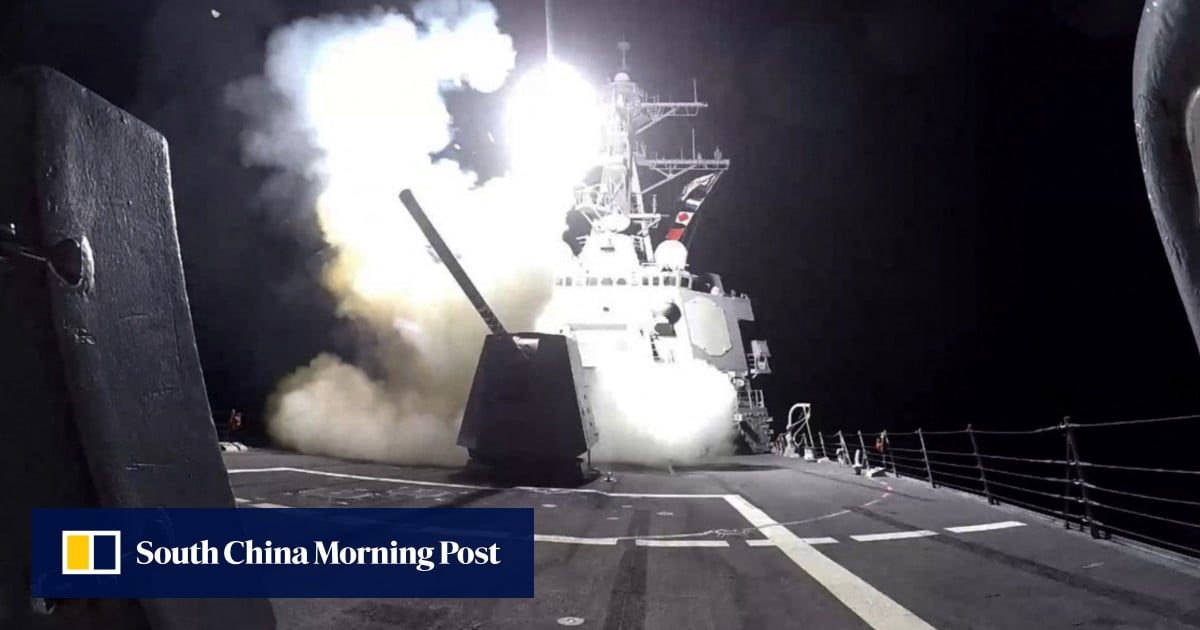The campaign has boosted the rebels’ standing in the Arab world, despite their human rights abuses in a years-long stalemated war with several of America’s allies in the region.
Analysts warn that the longer the Houthis’ attacks go on, the greater the risk that disruptions to international shipping will begin to weigh on the global economy.
Iran warns US of targeting suspected spy ships in Middle East
Iran warns US of targeting suspected spy ships in Middle East
The Rubymar, which reported problems with its propulsion in November, apparently became inoperable, forcing her crew to abandon the vessel.
Houthi military spokesman Brigadier General Yahya Saree claimed on Monday night that the Rubymar sank. However, satellite images from Planet Labs PBC showed the Rubymar still afloat at 2pm local time Tuesday just north of the Bab el-Mandeb. A large oil slick trailed the vessel.
The Rubymar attack marked one of a few direct, serious hits by the Houthi rebels on shipping. In late January, another direct hit set a Marshall Islands-flagged tanker ablaze for hours.
Meanwhile, the Houthis early Tuesday released footage of what they described as a surface-to-air missile bringing down a US MQ-9 Reaper drone off the coast of Hodeida, a Yemeni port city they hold on the Red Sea. The footage included a video of men dragging pieces of debris from the water onto a beach.
Images of the debris, which included writing in English and what seemed to be electrical equipment, appeared to correspond to known pieces of the Reaper, usually used in attack missions and surveillance flights. Pentagon spokeswoman Sabrina Singh told journalists in a briefing the Houthis shot down the drone.
In November, the Pentagon acknowledged the loss of an MQ-9, also shot down by the rebels over the Red Sea.

Since the Houthis seized the country’s north and its capital of Sanaa in 2014, the US military has lost at least four drones to shootdowns by the rebels – in 2017, 2019 and this year.
Meanwhile, the Houthis claimed an attack on the Sea Champion, a Greek-flagged, US-owned bulk carrier full of grain bound for Aden, Yemen, carrying grain from Argentina.
Central Command said the carrier “has delivered humanitarian aid to Yemen 11 times in the past five years” as the country remains on the edge of famine amid the war there.
Cargo ship seized by Yemen’s Houthis now a ‘tourist attraction’
Cargo ship seized by Yemen’s Houthis now a ‘tourist attraction’
The rebels separately claimed an attack on the Marshall Islands-flagged bulk carrier Navis Fortuna, a ship that had been broadcasting its destination as Italy with an “all Chinese” crew to avoid being targeted. Private security firm Ambrey reported that the vessel sustained minor damage in a drone attack.
The US shot down 10 bomb-carrying Houthi drones, as well as a cruise missile heading toward the Arleigh Burke-class destroyer USS Laboon over the last day, Central Command said Tuesday.
The US military also conducted strikes targeting a Houthi surface-to-air missile launcher and a drone prior to its launch.

The Houthis acknowledged the drone attacks and claimed other assaults not immediately acknowledged by the West.
Since November, the rebels have repeatedly targeted ships in the Red Sea and surrounding waters over Israel’s war against Hamas in the Gaza Strip.
They have frequently targeted vessels with tenuous or no clear links to Israel, imperilling shipping in a key route for trade among Asia, the Mideast and Europe. Those vessels have included at least one with cargo for Iran, the Houthis’ main benefactor.
The European Union has launched its own campaign to protect shipping, with member France saying on Tuesday that it shot down two Houthi drones overnight in the Red Sea.
So far, no US sailor or pilot has been wounded by the Houthis since America launched its air strikes targeting the rebels in January.
However, the US continues to lose drones worth tens of millions of dollars and fire million-dollar cruise missiles to counter the Houthis, who are using far cheaper weapons that experts believe largely have been supplied by Iran.
Based on US military statements, American and allied forces have destroyed at least 73 missiles of different types before they were launched, as well as 17 drones, 13 bomb-laden drone boats and one underwater explosive drone over their month-long campaign, according to an AP tally.

Those figures don’t include the initial January 11 joint US-UK strikes that began the campaign. The American military also has shot down dozens of missiles and drones already airborne since November.
The Houthis haven’t offered much information regarding their losses, though they’ve acknowledged at least 22 of their fighters have been killed in the American-led strikes.
Insurgent forces including the Houthis and allied tribes in Yemen number around 20,000 fighters, according to the International Institute for Strategic Studies. They can operate in small units away from military bases, making targeting them more difficult.
The Houthis may view the costs as balanced by their sudden fame within an Arab world enraged by the killing of women and civilians by Israel in Gaza.
If the Houthi attacks continue, it could force the US to intensify and widen its counter-attacks across an already volatile Mideast.
“Without a ceasefire in Gaza, the Houthis could be tempted to further escalate against US interests in the Red Sea and in the region,” wrote Eleonora Ardemagni, a fellow at the Italian Institute for International Political Studies.
For Washington, “deterrence options” are getting narrower, she added.

